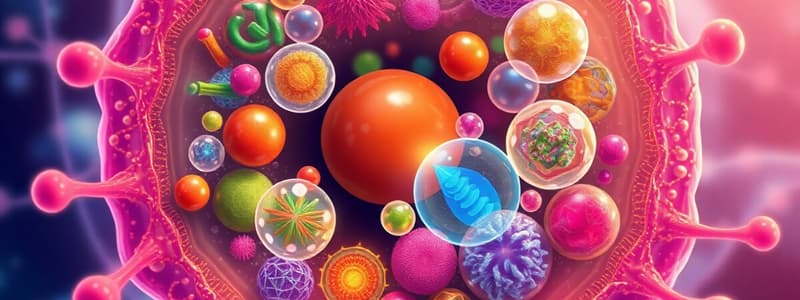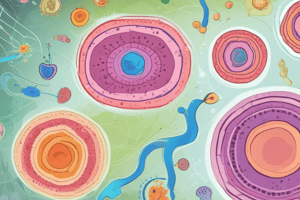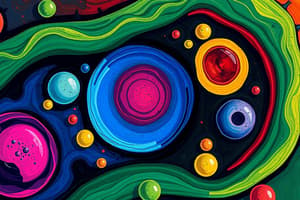Podcast
Questions and Answers
Questions are hidden until you start the quiz
Flashcards
What is cytoplasm?
What is cytoplasm?
The jelly-like substance inside a cell that contains all the organelles.
What is cellular respiration?
What is cellular respiration?
A process that converts glucose (sugar) into ATP, the cell's energy currency.
What is a population?
What is a population?
Groups of organisms of the same species living in a particular area.
What is evolution?
What is evolution?
Signup and view all the flashcards
What is natural selection?
What is natural selection?
Signup and view all the flashcards
Study Notes
Cell Structure and Function
- Cells are the fundamental units of life, possessing various organelles with specific functions.
- A cell membrane encloses the cytoplasm, a jelly-like substance containing organelles.
- The nucleus, containing DNA, controls cellular activities.
- Mitochondria are responsible for energy production through cellular respiration.
- Ribosomes synthesize proteins.
- Endoplasmic reticulum (ER) modifies and transports proteins.
- Golgi apparatus processes and packages proteins.
- Lysosomes break down waste materials.
- Vacuoles store various substances.
- Cytoskeleton provides structural support and facilitates movement.
Types of Cells
- Prokaryotic cells lack a nucleus and membrane-bound organelles. Examples are bacteria and archaea.
- Eukaryotic cells possess a nucleus and membrane-bound organelles. Examples are plant and animal cells.
- Plant cells have a rigid cell wall, chloroplasts (for photosynthesis), and a large central vacuole, characteristics not present in animal cells.
Cellular Processes
- Cellular respiration converts glucose into ATP, the cell's primary energy source.
- Photosynthesis converts light energy into chemical energy in the form of glucose.
- Mitosis is a process of cell division resulting in two identical daughter cells.
- Meiosis is a specialized cell division producing gametes (sex cells) with half the number of chromosomes, crucial for sexual reproduction.
Biological Molecules
- Four main classes of biological molecules: carbohydrates, lipids, proteins, and nucleic acids.
- Carbohydrates provide energy and structural support.
- Lipids store energy, form membranes, and act as hormones.
- Proteins perform diverse functions, including catalysis, transport, and structural support.
- Nucleic acids store and transmit genetic information (DNA and RNA).
Ecology
- Ecology is the study of the relationships between organisms and their environment.
- Ecosystems consist of biotic (living) and abiotic (non-living) components.
- Populations are groups of organisms of the same species in a given area.
- Communities include all populations within an area.
- Biomes are large-scale regions characterized by specific climate and vegetation.
- Food webs show the flow of energy and nutrients through an ecosystem, illustrating interconnectedness.
Evolution
- Evolution is the change in the heritable characteristics of biological populations over successive generations.
- Natural selection is a key mechanism of evolution, where organisms better adapted to their environment tend to survive and reproduce.
- Genetic variation is essential for evolution to occur, providing raw material for selection.
- Common ancestry suggests that all life forms share a common ancestor, a unifying concept in evolutionary biology.
Genetics
- Genetics is the study of genes, heredity, and variation in organisms.
- Genes are segments of DNA that code for specific traits.
- Chromosomes are thread-like structures containing DNA.
- DNA carries the genetic information, which is passed from parents to offspring.
- Mendelian genetics describes patterns of inheritance based on dominant and recessive traits.
- Modern genetics uses molecular techniques to study genes and their function, advancing understanding of heredity.
Diversity of Life
- Organisms are classified into different groups based on shared characteristics.
- Classification systems (e.g., Linnaean system) organize organisms based on evolutionary relationships, reflecting shared ancestry.
- Three domains of life: Bacteria, Archaea, and Eukarya.
- Each domain contains different kingdoms, including Plantae, Animalia, Fungi, Protista, etc., each with characteristic traits reflecting evolution.
Homeostasis
- Homeostasis is the ability of an organism to maintain a stable internal environment, even when external conditions change, essential for survival.
- Organisms use various mechanisms (e.g., feedback loops, organ systems) to maintain homeostasis.
- Maintaining homeostasis is crucial for the survival and proper functioning of organisms in varied environments.
Physiology
- Physiology studies the functions and mechanisms in living organisms.
- Organ systems work together to maintain homeostasis and carry out specific functions.
- Examples include the digestive, respiratory, circulatory, and nervous systems, among others, each playing distinct roles in overall organism function.
Studying That Suits You
Use AI to generate personalized quizzes and flashcards to suit your learning preferences.




